Soufflé
A soufflé is a baked egg-based dish originating in the Kingdom of France in the early 18th century. Combined with various other ingredients, it can be served as a savory main dish or sweetened as a dessert. The word soufflé is the past participle of the French verb souffler which means "to blow," "to breathe," "to inflate," or "to puff."[1][2][3]
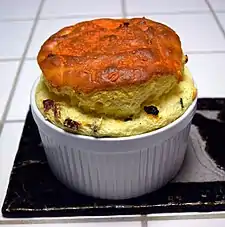 | |
| Type | Egg-based dish |
|---|---|
| Place of origin | France |
| Main ingredients | Egg yolks, egg whites |
History
The earliest mention of the soufflé is attributed to French master cook Vincent La Chapelle, in the early eighteenth century.[1] The development and popularization of the soufflé is usually traced to French chef Marie-Antoine Carême in the early nineteenth century.[4][5]
Ingredients and preparation
Soufflés are typically prepared from two basic components:
- a flavored crème pâtissière,[6] cream sauce or béchamel,[6] or a purée[2][6] as the base
- egg whites beaten to a soft peak[2]
The base provides the flavor, and the egg whites provide the "lift" or puffiness to the dish.[1][2] Foods commonly used to flavor the base include herbs, cheese and vegetables[1] for savory soufflés and jam,[7] fruits,[8] berries,[9] chocolate,[10] banana[11] and lemon[12] for dessert soufflés.
Soufflés are generally baked in ramekins or soufflé dishes: these are typically glazed, flat-bottomed, round porcelain containers with unglazed bottoms, vertical or nearly vertical sides and fluted exterior borders. The ramekin, or another baking vessel, may be coated with a thin film of butter to prevent the soufflé from sticking.[6] Some preparations also include adding a coating of sugar, bread crumbs, or a grated hard cheese such as parmesan inside the ramekin in addition to the butter; some cooks believe this allows the soufflé to rise more easily.[6]
After being cooked, a soufflé is puffed up and fluffy,[2] and it will generally fall after 5 or 10 minutes (as risen dough does). It may be served with a sauce atop the soufflé, such as a sweet dessert sauce,[13][14][15] or with a sorbet or ice-cream on the side.[16] When served, the top of a soufflé may be punctured with serving utensils to separate it into individual servings.[17] This can also enable a sauce to integrate into the dish.
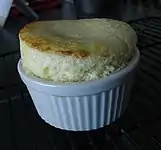 Lemon soufflé
Lemon soufflé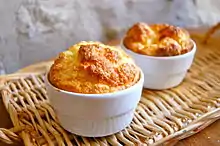 Cheese soufflés
Cheese soufflés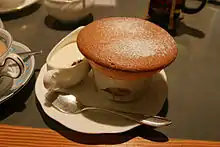 A soufflé at a Japanese restaurant
A soufflé at a Japanese restaurant Soufflé in a ramekin
Soufflé in a ramekin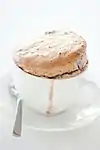 Berry soufflé in a coffee cup
Berry soufflé in a coffee cup
Variations
There are a number of both savory and sweet soufflé flavor variations.[18] Savory soufflés often include cheese, and vegetables such as spinach,[2] carrot[19][20] and herbs, and may sometimes incorporate poultry, bacon, ham, or seafood for a more substantial dish. Sweet soufflés may be based on a chocolate or fruit sauce (lemon or raspberry, for example) and are often served with a dusting of powdered sugar.[21] Frugal recipes sometimes emphasize the possibilities for making soufflés from leftovers.[22]
A soufflé may be served alone, with ice cream,[23] fruit, or a sauce.[15]
Apple soufflé is made by lining a cake tin with pureed rice boiled in sweetened milk and baking it until it sets. The rice "border" is filled with thickened apple marmalade and whipped egg whites and baked until it rises.[24]
- Soufflé variations
 Cheese soufflé in a casserole dish
Cheese soufflé in a casserole dish Soufflé served with ice cream
Soufflé served with ice cream Chocolate soufflé with lava centre served with ice cream
Chocolate soufflé with lava centre served with ice cream
See also
References
- Peterson, J. (2012). Glorious French Food: A Fresh Approach to the Classics. Houghton Mifflin Harcourt. pp. 130–132. ISBN 978-0-544-18655-2.
- Taylor, Carol (March 1988). "How to Make a Soufflé". Mother Earth News. Retrieved 17 August 2015.
- "Soufflet". cnrtl.fr. Retrieved 18 August 2015.
- Wells, Patricia (22 February 1978). "Perfect Souffles Don't Require Expert Skills". The Eagle. p. 26 – via Newspapers.com.

- Mallet, Gina (2004). Last Chance to Eat: The Fate of Taste in a Fast Food World. W. W. Norton & Company. pp. 52–54. ISBN 9780393058413.
- Cloake, Felicity (15 September 2011). "How to cook perfect cheese soufflé". The Guardian. Retrieved 17 August 2015.
- McCoy, J. (2009). Healthy Meals for Less. Baker Publishing Group. p. 231. ISBN 978-1-4412-1087-6.
- Beard, J. (2015). The James Beard Cookbook. Open Road Media. p. 356. ISBN 978-1-5040-0449-7.
- Brownlee, H.; Caruso, M. (2007). The Low-Carb Gourmet: A Cookbook for Hungry Dieters. Random House Publishing Group. p. 73. ISBN 978-0-307-41721-3.
- Rombauer, I.S.; Becker, M.R.; Becker, E.; Guarnaschelli, M. (1997). Joy of Cooking. Scribner. p. 1033. ISBN 978-0-684-81870-2. Retrieved 17 August 2015.
- Pellaprat, H.P.; Tower, J. (2012). The Great Book of French Cuisine. Vendome Press. p. 1383. ISBN 978-0-86565-279-8.
- Zuckerman, K.; Rupp, T. (2009). The Sweet Life: Desserts from Chanterelle. Little, Brown. p. 170. ISBN 978-0-316-07033-1.
- Waldo, M. (1990). The Soufflé Cookbook. Dover Publications. p. 225. ISBN 978-0-486-26416-5.
- "Shivi Ramoutar's coconut soufflé with rum sauce". Metro. 1 July 2013. Retrieved 17 August 2015.
- Lewis, E. (2013). In Pursuit of Flavor. Knopf Doubleday Publishing Group. pp. 488–490. ISBN 978-0-385-35082-2.
- "Orange and Grand Mariner Soufflé". Retrieved 15 April 2017.
- Child, J.; Bertholle, L.; Beck, S. (2011). Mastering the Art of French Cooking. Knopf Doubleday Publishing Group. p. 331. ISBN 978-0-307-95817-4.
- Hesser, Amanda (8 March 2000). "The Modern Souffle: Bastion of Strength". The New York Times. Retrieved 23 August 2015.
- Tijerina, Edmund (7 May 2015). "Recipe Swap: Carrot Soufflé". San Antonio Express-News. Retrieved 17 August 2015.
- "Chef John Folse's Holiday Carrot Soufflé". WAFB 9 News. 6 November 2001. Retrieved 17 August 2015.
- Mushet, Cindy (2008). The Art and Soul of Baking. Andrews McMeel Publishing. p. 375. ISBN 9780740773341.
- "Good Cookery: Souffles, alias Puffs". Fitchburg Sentinel. 9 May 1899. p. 11 – via Newspapers.com.

- "Warm Milk Chocolate Souffles with Vanilla Ice Cream Recipe". Epicurious. 1 November 2002. Retrieved 17 August 2015.
- Beeton, Isabella (1865). Mrs. Beeton's Dictionary of Every-day Cookery.
Further reading
- Waldo, M. (1990). The Soufflé Cookbook. Dover Publications. ISBN 978-0-486-26416-5. 241 pages.